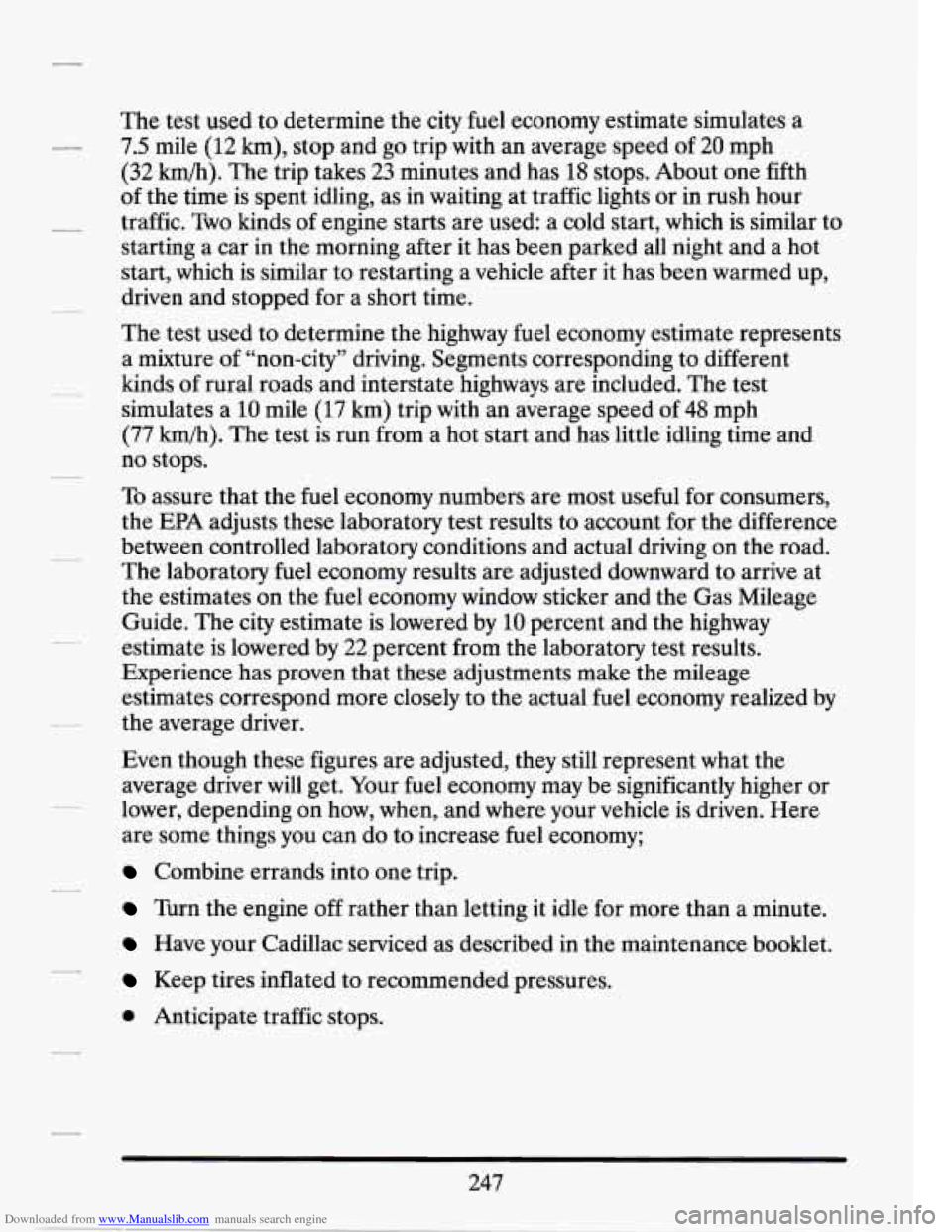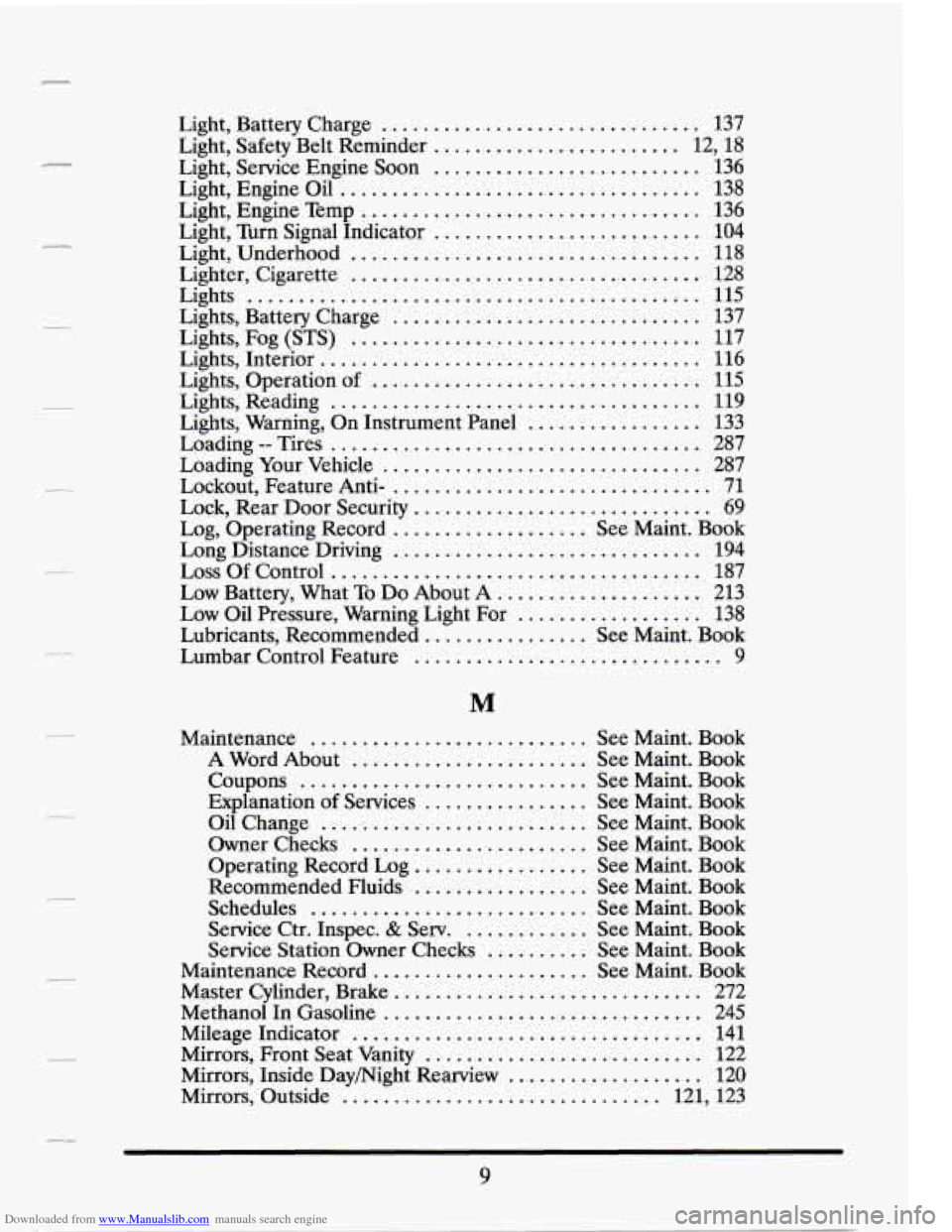1994 CADILLAC SEVILLE gas mileage
[x] Cancel search: gas mileagePage 259 of 399

Downloaded from www.Manualslib.com manuals search engine FUELS IN FOREIGN COUNTHES
If you plan on driving in another country outside the U.S. or Canada,
unleaded fuel may be hard to find. Do not use leaded gasoline. If you use
even one tankful, your emission controls won’t work well or at all. With
continuous use, spark plugs can get fouled, the exhaust system can
corrode, and your engine oil can deteriorate quickly. Your vehicle’s
oxygen sensor will be damaged. All of that means costly repairs that
wouldn’t be covered by your warranty.
To check on fuel availability, ask an auto club, or contact a major oil
company that does business in the country where you’ll be driving.
You can also write us at the following address for advice. Just tell us
where you’re going and give your Vehicle Identification Number (VIN).
General Motors Overseas Distribution Corporation,
North American Export Sales (NAES)
1908 Colonel Sam Drive
Oshawa, Ontario
L1H 8P7
FUEL ECOlVOhfY
Your fuel economy (miles per gallon or liters per 100 kilometers) can vary
depending on how your Cadillac is driven. Several vehicles like yours
have been driven through a standard test and their actual fuel economy
was recorded. These readings were adjusted and printed on the fuel
economy window sticker which was attached to your
new Cadillac when it
was delivered and in the Gas Mileage Guide which is available from your
dealership.
c
The fuel economy estimates are based on results of tests required by the
U. S. Environmental Protection Agency (EPA). These tests are used to
certify that vehicles meet the Federal emissions and fuel economy
standards. Cadillac tests prototypes of new vehicles and submits the results
to the EPA. The EPA then confirms the accuracy
of the figures provided by
Cadillac. The vehicles are driven by a professional driver under controlled
-
laboratory conditions, on an instrument similar to a treadmill. These
procedures ensure that each vehicle is tested under identical conditions.
There are
two different fuel economy estimates for each vehicle, one for
city driving and one for highway driving.
To develop these two estimates,
separate tests are used to represent typical everyday city and rural driving.
LI
.
246
Page 260 of 399

Downloaded from www.Manualslib.com manuals search engine -
The test used to determine me city fuel economy estimate simulates a
7.5 mile
(12 km), stop and go trip with an average speed of 20 mph
(32 km/h). The trip takes 23 minutes and has 18 stops. About one fifth
of the time is spent idling, as in waiting at traffic lights or in rush hour
traffic. Two kinds
of engine starts are used: a cold start, which is similar to
starting a car in the morning after it has been parked all night and a hot
start, which is similar to restarting
a vehicle after it has been warmed up,
driven and stopped for a short time.
The test used to determine the highway fuel economy estimate represents
a mixture
of “non-city” driving. Segments corresponding to different
kinds of rural roads and interstate highways are included. The test
simulates a
10 mile (17 km) trip with an average speed of 48 mph
(77
km/h). The test is run from a hot start and has little idling time and
no stops.
To assure that the fuel economy numbers are most useful for consumers,
the EPA adjusts these laboratory test results to account for the difference
between controlled laboratory conditions and actual driving on the road.
The laboratory fuel economy results are adjusted downward to arrive at
the estimates on the fuel economy window sticker and the Gas Mileage
Guide. The
city estimate is lowered by 10 percent and the highway
estimate is lowered by
22 percent from the laboratory test results.
Experience has proven that these adjustments make the mileage
estimates correspond more closely to the actual fuel economy realized by
the average driver.
Even though these figures are adjusted, they still represent what the
average driver will get. Your fuel economy may be significantly higher or
lower, depending on how, when, and where your vehicle is driven. Here
are some things you can do to increase fuel economy;
Combine errands into one trip.
Turn the engine off rather than letting it idle for more than a minute.
Have your Cadillac serviced as described in the maintenance booklet.
Keep tires inflated to recommended pressures.
0 Anticipate traffic stops.
247
Page 390 of 399

Downloaded from www.Manualslib.com manuals search engine Light, Battery Charge ............................... 137
Light, Safety Belt Reminder ........................ 12,18
Light, Service Engine Soon .......................... 136
Light, Engine Oil ................................... 138
Light, Engine Temp ................................. 136
Light, Turn Signal Indicator .......................... 104
Light, Underhood .................................. 118
Lighter, Cigarette .................................. 128
Lights ............................................ 115
Lights, Battery Charge .............................. 137
Lights, Fog (STS) .................................. 117
Lights, Interior ..................................... 116
Lights, Operation of ................................ 115
Lights, Reading .................................... 119
Lights, Warning, On Instrument Panel ................. 133
Loading -- Tires .................................... 287
Loading Your Vehicle ............................... 287
Lockout, Feature Anti- ............................... 71
Lock, Rear Door Security ............................. 69
Log, Operating Record ................... See Maint. Book
Long Distance Driving .............................. 194
Loss Of Control .................................... 187
Low Battery, What To Do About A .................... 213
Low Oil Pressure, Warning Light For .................. 138
Lubricants, Recommended ................ See Maint. Book
Lumbar Control Feature
.............................. 9
M
Maintenance ........................... See Maint. Book
A Word About
....................... See Maint. Book
Coupons
............................ See Maint. Book
Explanation of Services ................ See Maint. Book
Oil Change
.......................... See Maint. Book
Owner Checks
....................... See Maint. Book
Operating Record Log
................. See Maint. Book
Recommended Fluids
................. See Maint. Book
Schedules
........................... See Maint. Book
Service Ctr. Inspec.
& Sen. ............ See Maint. Book
Service Station Owner Checks
.......... See Maint. Book
Maintenance Record
..................... See Maint. Book
Master Cylinder, Brake
.............................. 272
Methanol In Gasoline ............................... 245
Mirrors, Front Seat Vanity ........................... 122
Mirrors, Inside Daymight Rearview ................... 120
Mirrors, Outside ............................... 121,123
MileageIndicator .................................. 141